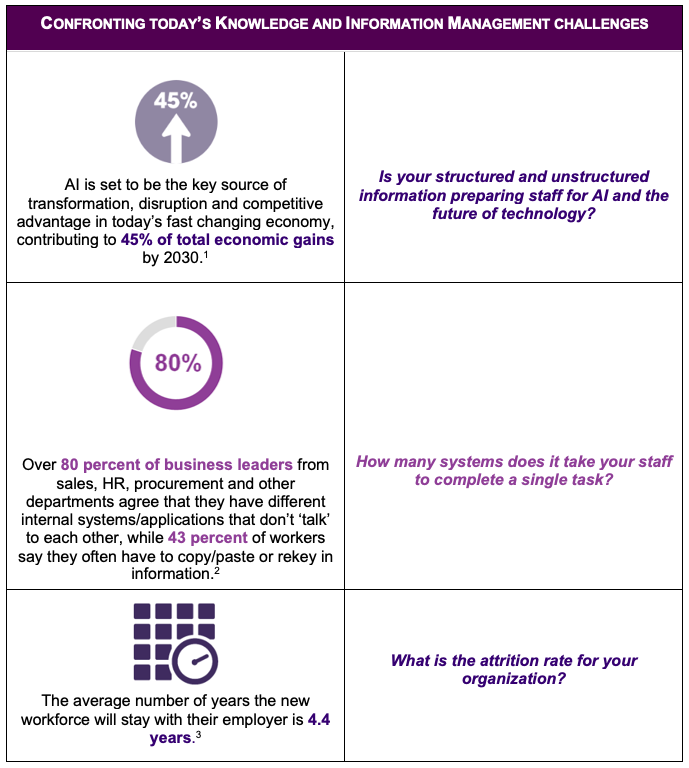For many organizations, investment decisions on Knowledge, Data, and Information Management initiatives are driven by high-level business objectives such as increased efficiency, productivity, competitive advantage, and enhanced employee or customer engagement. While aligning Knowledge and Information Management initiatives with business objectives is critical, it can be a challenge to measure these broad objectives or show a positive correlation that these initiatives are achieving the desired results. So, how do you know if you need to invest in Knowledge and Information Management initiatives?
In our experience partnering with hundreds of clients around the world, we regularly address questions around the business value of Knowledge and Information Management:
- Why should we invest in Knowledge and Information Management?
- How can I calculate the ROI to justify the return or impact to my bottom line?
- How do we know and show when we are hitting our mark?
- What are other organizations doing about it?
This two-part blog series, “The Cost of Doing Nothing: The Business Value of Knowledge and Information Management” will explore these questions and answer them with direct experience and relevant case studies.
Part 1: Defining and Prioritizing Your Knowledge and Information Management Needs
Help organizational leaders and Knowledge and Information Management champions understand and define current needs and make priority alignments to define an effective strategy and roadmap.
Defining Your Knowledge, Information and Data Management Needs
At EK, when we talk about knowledge, data, and/or information management, we take two aspects into consideration:
- Knowledge Management: the foundational components of an organization, including the people, processes, content, culture, and technologies that enable the organization to transform its tacit knowledge and experience into structured process and content; and
- Data & Information Management: the structured content and data which enable the organization to act on its knowledge by serving as a single-source of truth for finding, sharing, and collaborating on the right content and data at the time of need.
When considering practical business applications and outcomes, it’s important to remember that while Knowledge Management organizes our unstructured content, Data and Information Management helps us drive value out of our structured information.
In other words, doing one and not both only addresses half of our information challenges. And doing both, but in an uncoordinated fashion, will reinforce existing siloes. The table below provides examples of the most shared business outcomes that could be realized as a result investing in both.
As long as both sides of these concepts are covered in an integrated manner, there is usually no need to spend much time defining what is Knowledge Management, and what is Data and Information management. In reality, the lines between these disciplines blur as organizations shift focus to overarching business values and outcomes and time spent trying to draw hard lines typically is not worthwhile.
Making Priority Decisions
It is reasonable that most companies gravitate toward tangible investments, such as adding new product lines, expanding their sales footprint, and other strategies that hit the top line. While it may seem like not the right time or may be cheaper to ignore Knowledge and Information Management, it is likely costing your organization more than you realize. Here are some data points to help your organization extrapolate the tangible costs of doing nothing:
Making Knowledge and Information Management a Priority
Business priorities and outcomes for Knowledge and Information Management widely vary depending on organizational strategic goals and the maturity level of the organization’s current Knowledge and Information Management landscape. Mature organizations may need to streamline and scale Knowledge and Information Management efforts at the enterprise level. Early stage organizations may need to cultivate an understanding of the challenges and secure initial buy-in to invest in Knowledge and Information Management strategy and its implementation. Across the maturity spectrum however, successful Knowledge and Information Management efforts are focused on outcomes that help the organization meet critical business objectives.
If you are looking for ways to challenge your status quo and articulate the relevant business values of Knowledge and Information Management for your organization, we are here to help. In the meantime, here are a few steps to get you started:
- Understand your current state – examine your current landscape to have a complete understanding of your current Knowledge and Information Management strengths and weaknesses to priority business value. Identify a target state to develop a roadmap for long term implementation and success indicators to make relevant decisions about KM investments and priorities.
- Determine your Knowledge and Information Management maturity level: leverage our proprietary KM Maturity Benchmark, developed based on over 20 years of experience, to analyze your results against 40+ Knowledge and Information Management performance indicators.
- Define your Knowledge and Information Management vision and align priorities to gain executive buy-in: define what’s most relevant to your business and staff, your desired outcomes, and how to measure success against those outcomes.
Part two of this blog series, “Measuring Knowledge and Information Management ROI, and Tracking Progress”, will provide sample case studies, metrics and success indicators to track and communicate the success of Knowledge and Information Management efforts.
1 2019 AI Predictions, Six AI priorities you can’t afford to ignore PWC, 2019
2 The Document Disconnect IDC Survey
3 Employee Tenure 2018 Bureau of Labor Statistics


